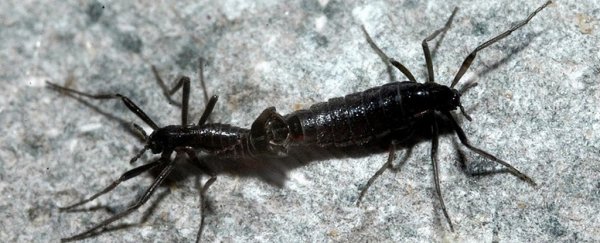Over tens of millions of years, the wingless midge Belgica antarctica has perfected the art of freezing itself to push through the darkest and coldest of Antarctica's winter months, carving out an exclusive niche as the continent's only native insect.
As climate change nudges polar temperatures ever higher, this hard-earned set of survival skills could ironically be detrimental to its very existence, potentially driving it to the brink of extinction.
Laboratory experiments conducted by a team of researchers from the US, UK, and South Africa showed warmer winters in the frozen south greatly impacted the insect's movements and energy stores, jeopardizing the chances of it seeing another summer.
Usually smaller than a centimeter from tip to tail, the itty-bitty arthropod also happens to hold the unlikely position of being the largest animal in the land to never set a toe in the ocean. Its entire life cycle – spent mostly in one of four larval states – takes place amid moist beds of moss and algae, chomping on the greenery and rotting waste.
Even these humble refuges freeze over during Antarctica's bitter winters, locking up precious moisture and threatening to turn the tiny critters into popsicles. So to hold out against the cold, the midge evolved a clever strategy to avoid death and bide its time.
As a guard against the trauma caused by ice crystals piercing its tissues, the midge slowly desiccates itself. Under the right conditions, individuals stand a good chance of making it through to summer, even after losing as much as three-quarters of its moisture.
That good chance depends a great deal on the humidity and whether it rehydrates using water vapor from the air or soaks it up directly from liquid water. Even small changes in the environmental conditions could make a big difference in survival rates.
In the Antarctic Peninsula – a region relatively rich in biodiversity – microclimates like those occupied by the midge tend to hover somewhere between -5 and 0 degrees Celsius (23 and 32 Fahrenheit). Protected by layers of snow and ice, temperatures can plummet in the atmosphere above, with little effect on the midge's mossy garden.
With temperatures steadily rising as much as half a degree per decade on the peninsula, those relatively protected conditions could be set to change. Higher temperatures could mean more precipitation, meaning more snow, creating thicker insulation and less chance of winter freezing.
To see exactly what effect this would have on B. antarctica, the researchers collected midge larvae from the surrounds of a station on Anvers Island at the very tip of the Antarctic Peninsula.
These specimens were then sent back to a lab in the US where they spent six months living under subtly different wintery conditions, ranging from a chilly -5 degrees Celsius up to a balmy -1 degree. Different kinds of substrate, such as moss and algae, were also tested.
On defrosting in ice water, the survivors were examined for signs of movement, tissue damage, and energy stores of carbohydrates, fats, and proteins.
That slight difference in temperature had a profound effect on the midge's recovery. Under typical conditions, around half of the insects made it through. Warmed by just a few degrees, a mere third survived. Energy stores also varied significantly, with more fat and protein stores being retained under cold conditions than in warmer ones.
"These results correspond with locomotor activity levels, where larvae from the warm winter regime were slowest, potentially due to energy drain," the researchers note in their report.
"With limited time prior to pupation after winter, and as adult B. antarctica lack functional mouthparts, energy store depletion during late larval instars would likely have irreversible consequences on the energy available for reproduction."
It's hard to say just what kind of impact this would have in the long run if temperatures continue to rise. Depending on the stresses posed by climate change, it could be a minor inconvenience or a blow that wipes out whole populations.
There is a possible silver lining, though: Warmer, winters could also be shorter, leaving the midge more time to collect larger stores during the summer months.
Whether this behavioral check counterbalances the negative impact of a warming environment is left to be measured.
With record heatwaves smashing the poles, the only insect to call Antarctica home could become yet one more victim of our rapidly changing climate.
This research was published in Functional Ecology.
